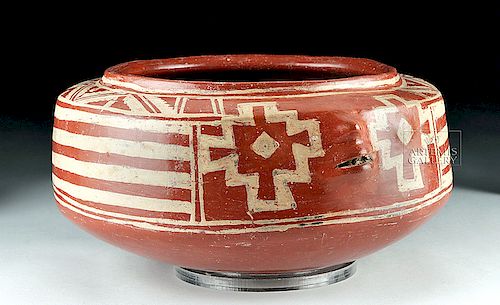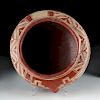Large Chupicuaro Pottery Head Vessel
Lot 11c
About Seller
Artemis Fine Arts
686 S Taylor Ave, Ste 106
Louisville, CO 80027
United States
Selling antiquities, ancient and ethnographic art online since 1993, Artemis Gallery specializes in Classical Antiquities (Egyptian, Greek, Roman, Near Eastern), Asian, Pre-Columbian, African / Tribal / Oceanographic art. Our extensive inventory includes pottery, stone, metal, wood, glass and textil...Read more
Estimate:
$7,000 - $10,000
Absentee vs Live bid
Two ways to bid:
- Leave a max absentee bid and the platform will bid on your behalf up to your maximum bid during the live auction.
- Bid live during the auction and your bids will be submitted real-time to the auctioneer.
Bid Increments
| Price | Bid Increment |
|---|---|
| $0 | $25 |
| $300 | $50 |
| $1,000 | $100 |
| $2,000 | $250 |
| $5,000 | $500 |
| $10,000 | $1,000 |
| $20,000 | $2,500 |
| $50,000 | $5,000 |
| $100,000 | $10,000 |
| $200,000 | $20,000 |
About Auction
By Artemis Fine Arts
May 10, 2018
Set Reminder
2018-05-10 10:00:00
2018-05-10 10:00:00
America/New_York
Bidsquare
Bidsquare : Fine Ethnographic / Asian / Ancient Art
https://www.bidsquare.com/auctions/artemis-gallery/fine-ethnographic-asian-ancient-art-3213
Featuring antiquities from around the world including Pre-Columbian, Tribal, Classical, Asian, so much more! Artemis Fine Arts info@artemisgallery.com
Featuring antiquities from around the world including Pre-Columbian, Tribal, Classical, Asian, so much more! Artemis Fine Arts info@artemisgallery.com
- Lot Description
Pre-Columbian, West Mexico, Guanajuato Valley, Chupicuaro, ca. 500 BCE to 300 CE. A fabulous, hand-built, bichrome pottery face bowl with a bold visage on one side presenting expressive features including a modeled nose, a gaping mouth, and raised eyes surrounded by abstract cross motifs - representative of a cross-section of the hallucinogenic San Pedro cactus. The rolling shoulder is decorated with zigzag, stepped, and linear motifs, painted in a creamy white hue atop the red-orange ground, with similarly-colored striped and X-shaped motifs embellishing the walls. A small lip leads inwards to a wide cavity, and both the interior and the rounded base are colored with red-orange slip. A pair of small cream-hued lines enclose the decorative register both above and below. A fabulous and finely-executed vessel from ancient West Mexico! Size: 10.25" W x 5.5" H (26 cm x 14 cm).
Chupicuaro society is well known for its sophisticated ceramic tradition featuring human effigies and food-service vessels of stunning aesthetic appeal such as this example. The feast was of utmost importance to supply food for the living as an integral part of social politics and also to provide sustenance for the soul's journey to the underworld. Beyond being objects for daily use, Chupicuaro ceramics were artistic achievements in their own right - elegant forms with boldly painted decoration typically in their signature deep red. The wide variety of vessel forms created by the Chupicuaro artisans points to the significance of the feast.
Provenance: private Hawaii, USA collection; ex-Allan Stone collection, New York, USA
All items legal to buy/sell under U.S. Statute covering cultural patrimony Code 2600, CHAPTER 14, and are guaranteed to be as described or your money back.
A Certificate of Authenticity will accompany all winning bids.
We ship worldwide and handle all shipping in-house for your convenience.
#132652Expected surface wear and abrasions, fading to some areas of coloration, with small nicks to rim, walls, base, and interior. The vessel has been skillfully repaired from a few large pieces with some well-executed restoration, resurfacing, and overpainting along break lines and to design motifs. Light earthen deposits throughout.Condition
- Shipping Info
-
All shipping is handled in-house for your convenience. Your invoice from Artemis Gallery will include shipping calculation instructions. If in doubt, please inquire BEFORE bidding for estimated shipping costs for individual items.
-
- Buyer's Premium



 EUR
EUR CAD
CAD AUD
AUD GBP
GBP MXN
MXN HKD
HKD CNY
CNY MYR
MYR SEK
SEK SGD
SGD CHF
CHF THB
THB


















